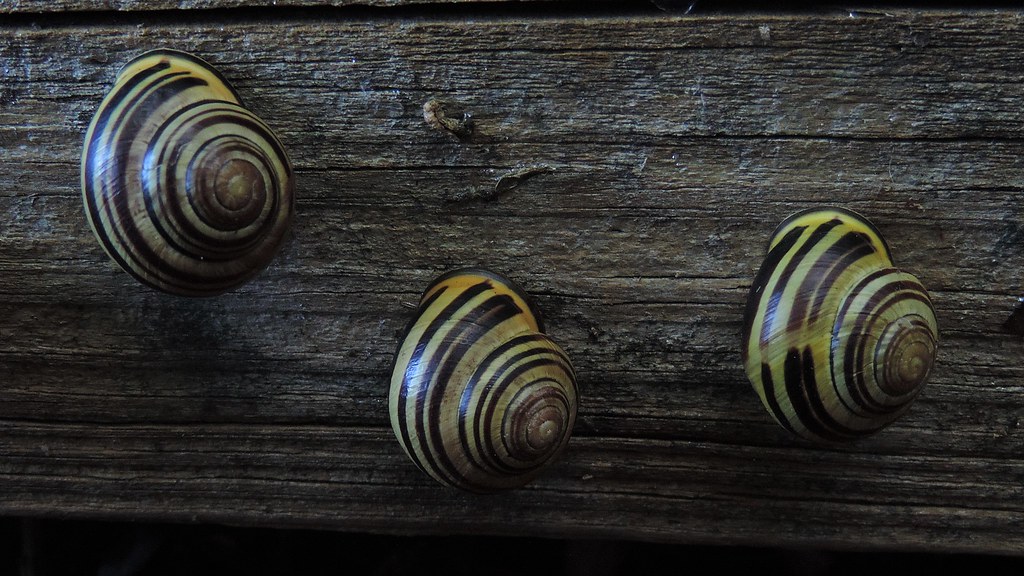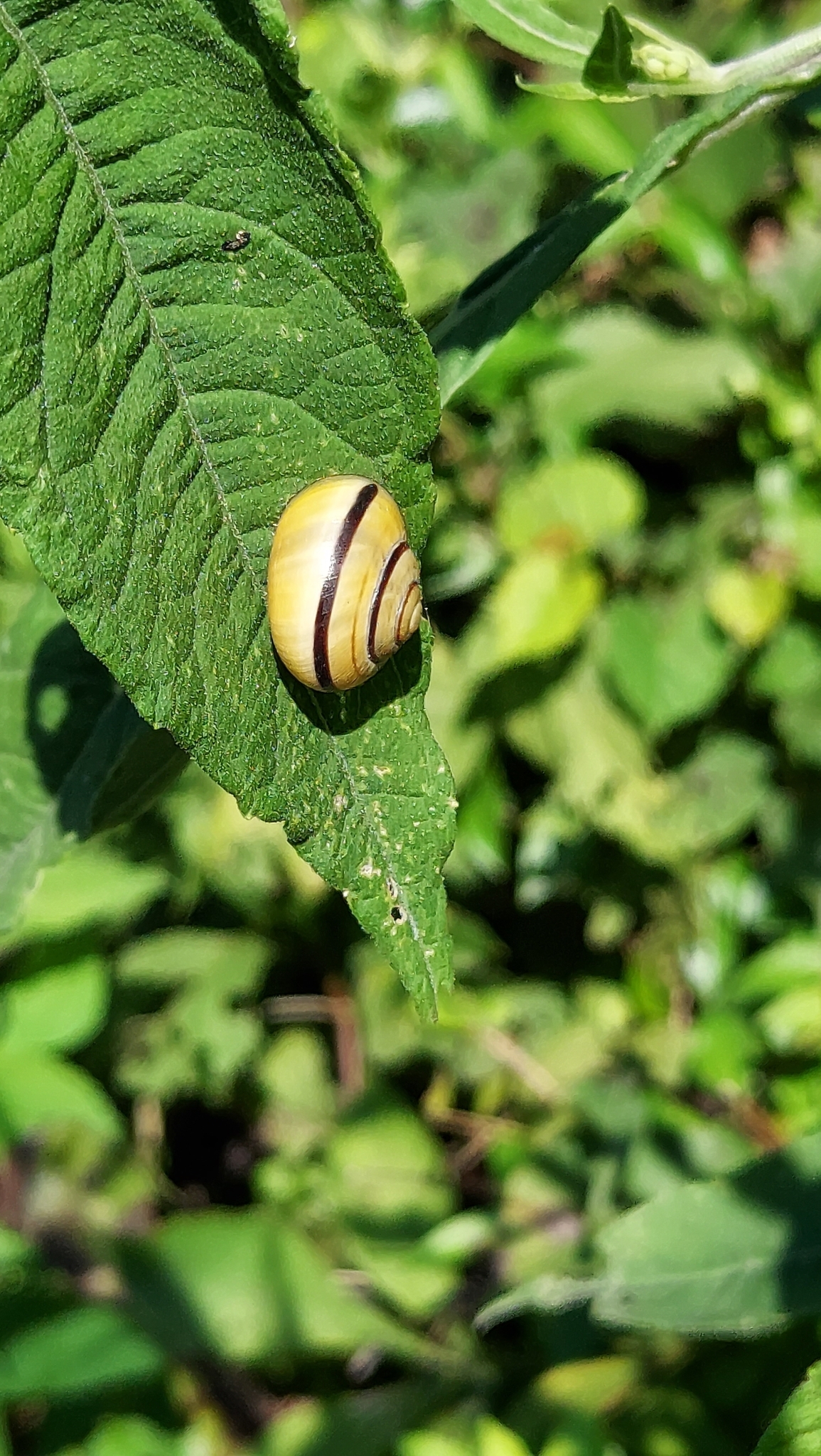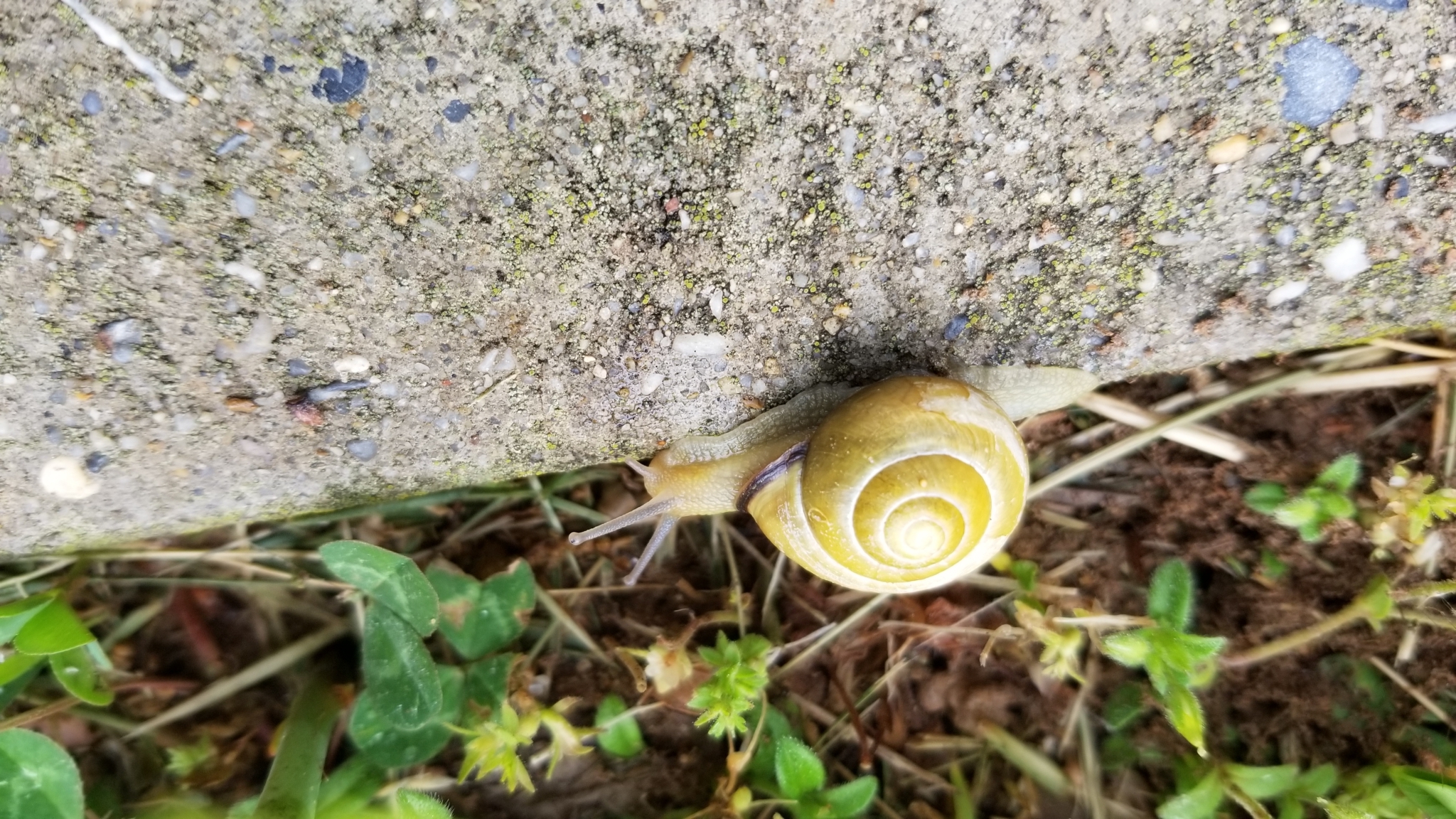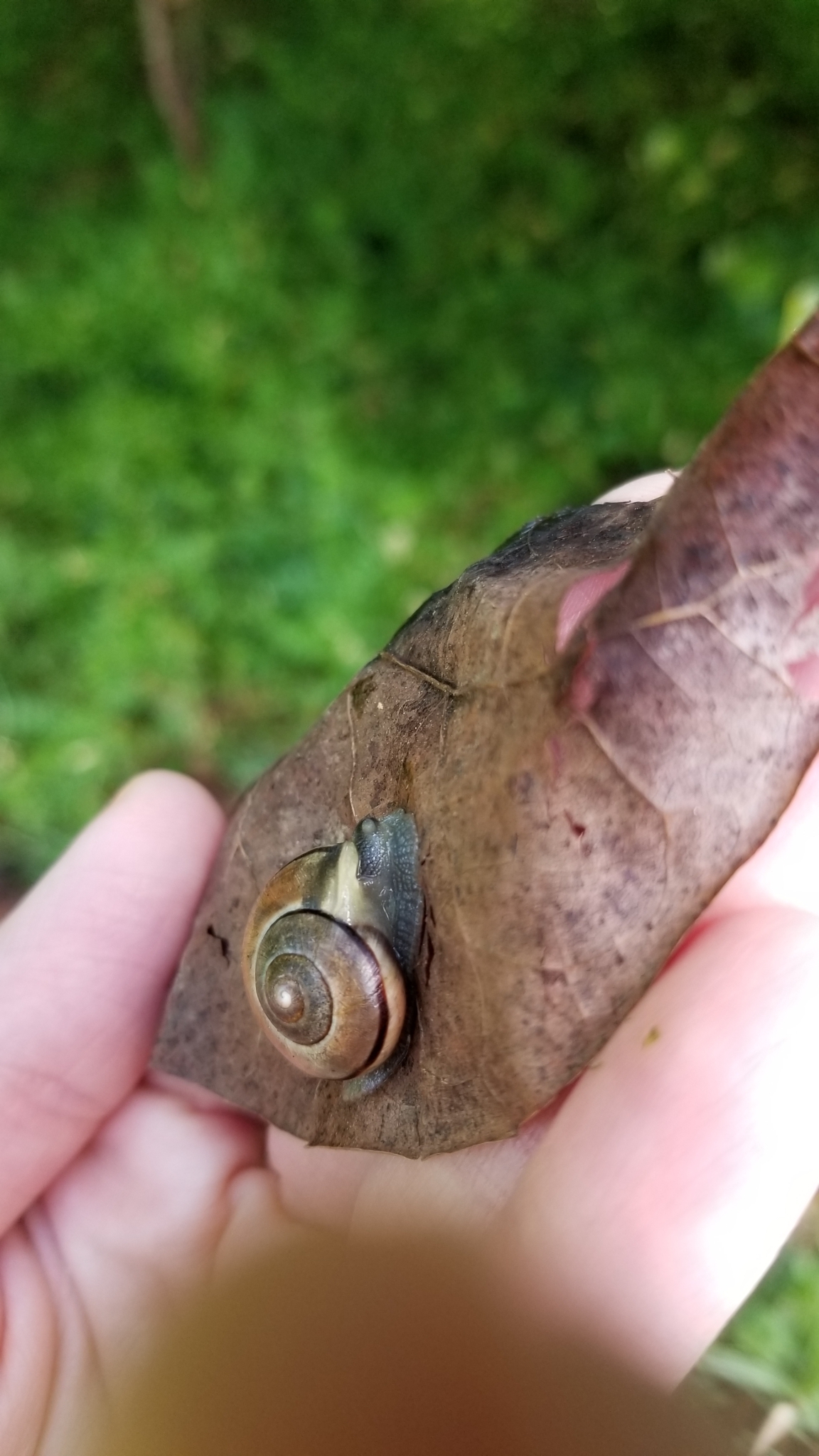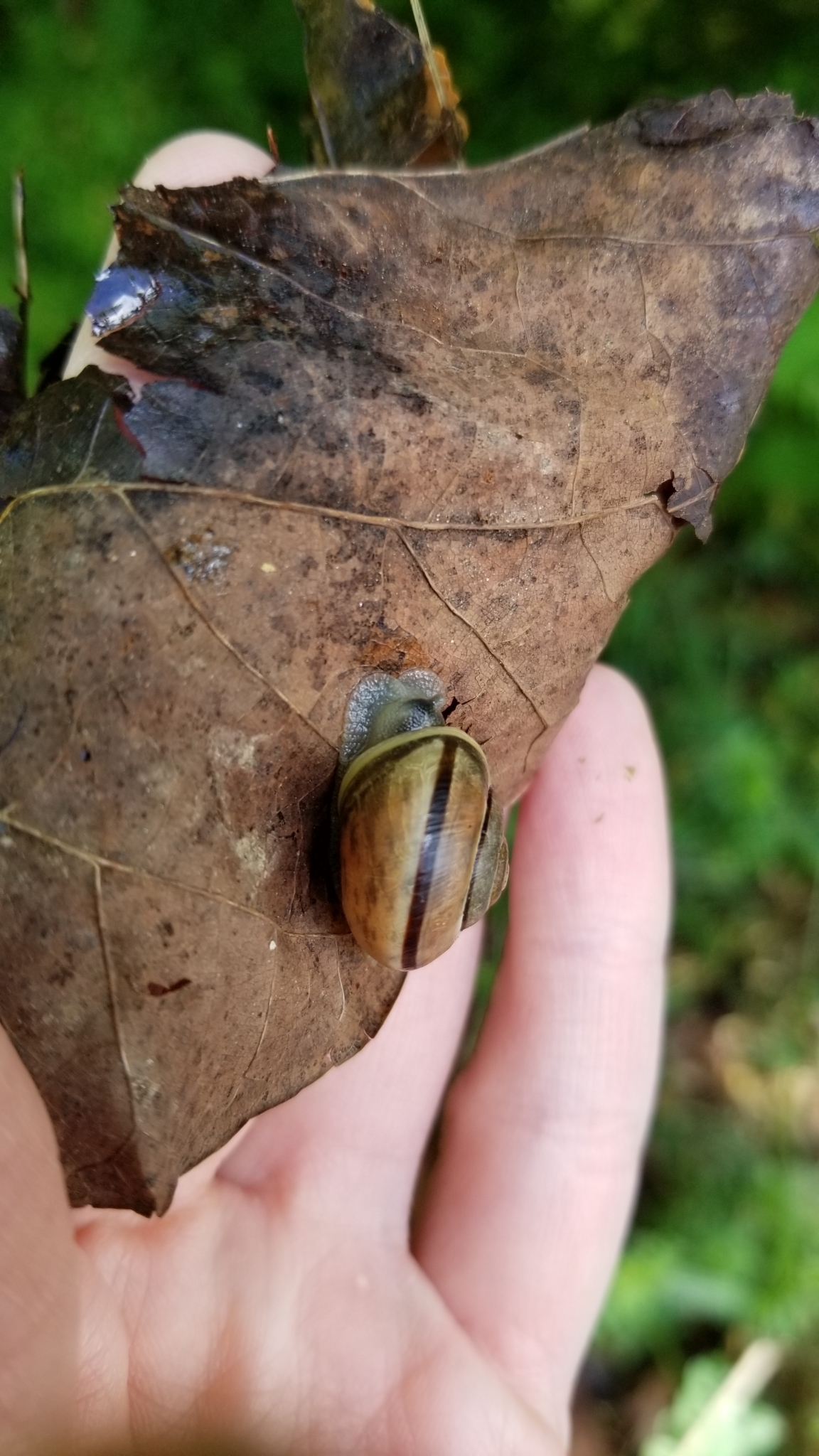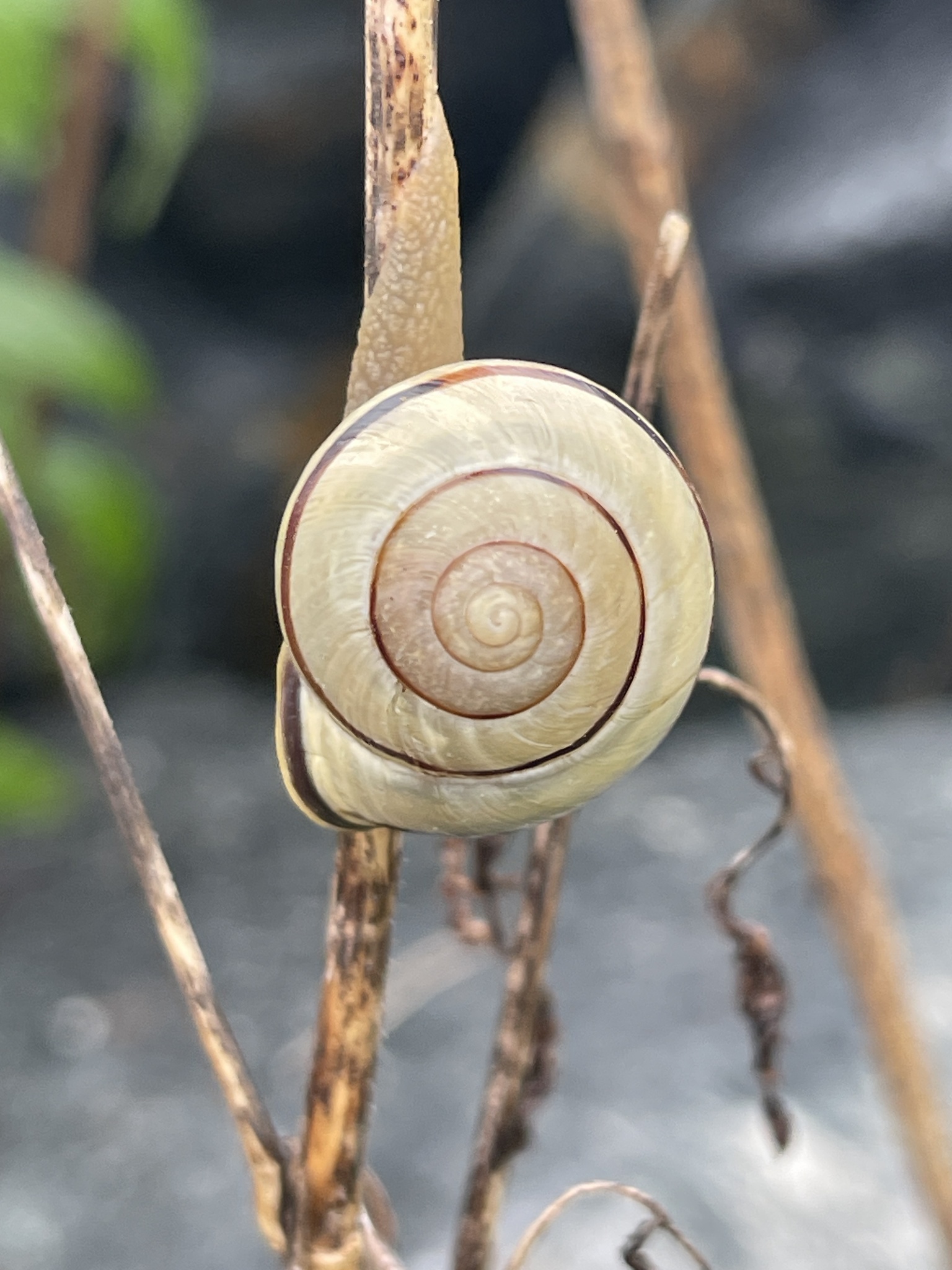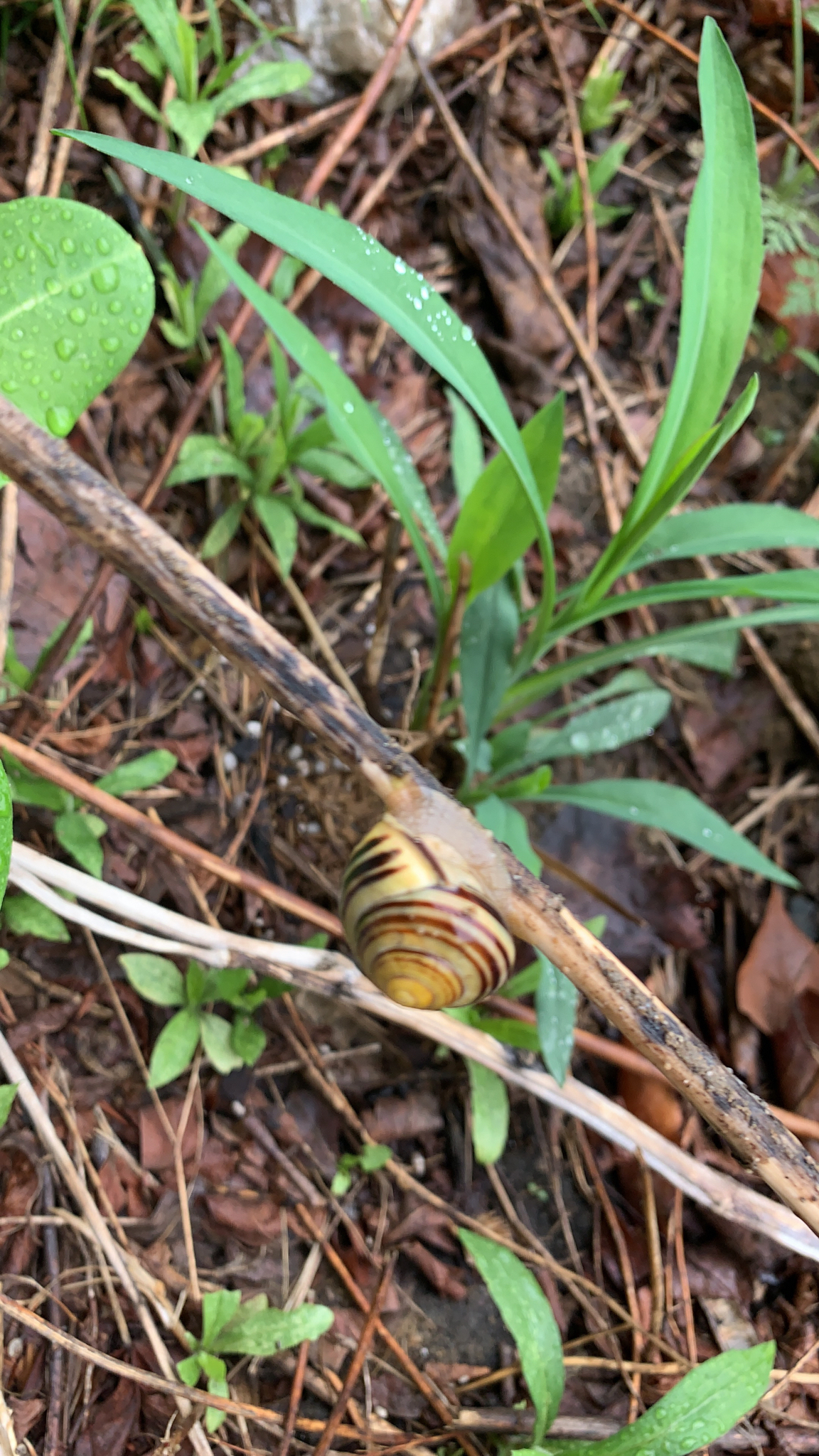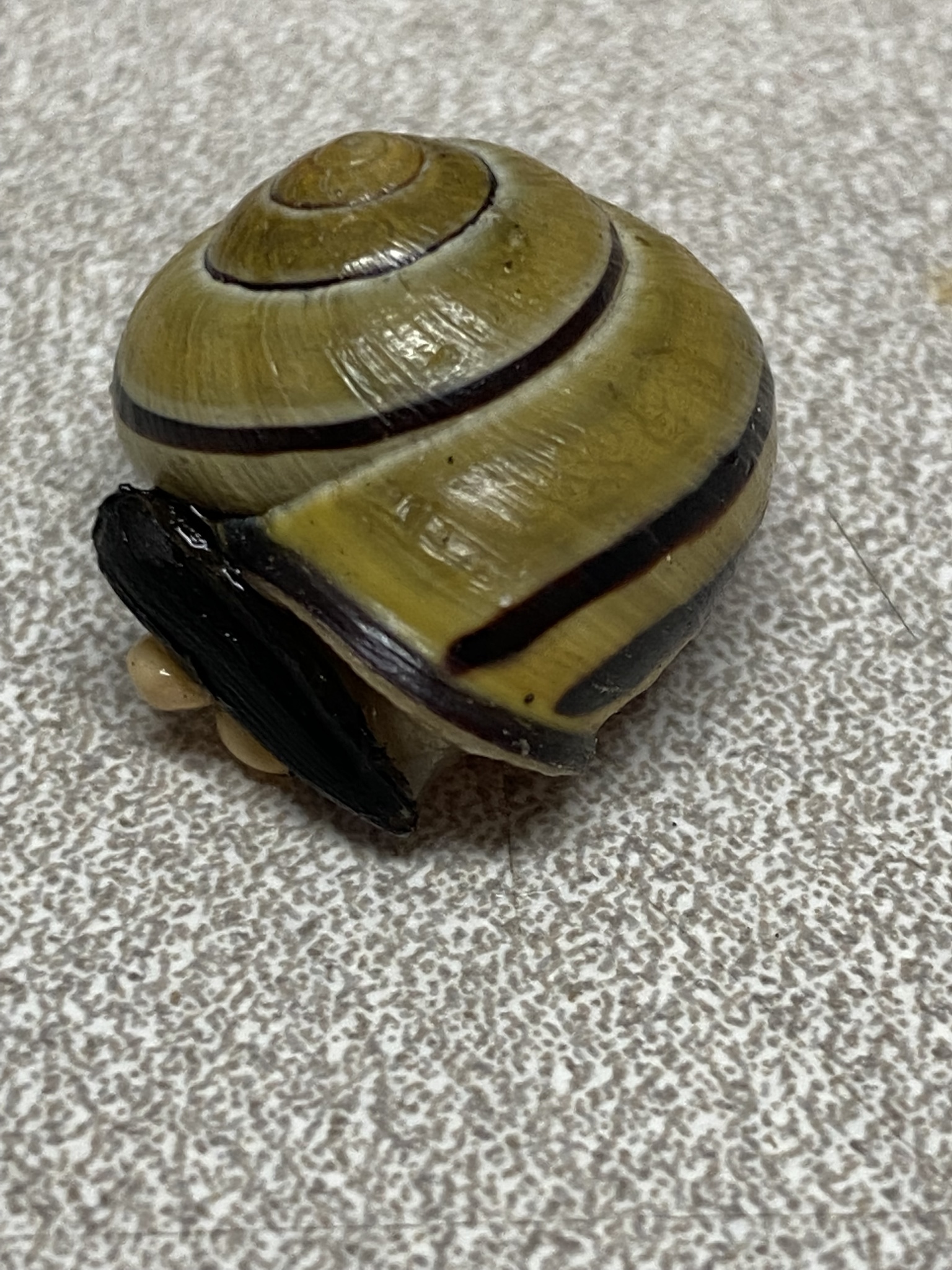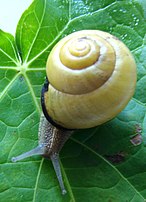Map Snapshot






11 Records
Status
This colorful snail has been widely introduced in North America from Europe. It is widespread in Maryland (J. Young, pers. comm.).
Seasonality Snapshot
Source: Wikipedia
| Lemon or Grove snail Cepaea nemoralis | |
|---|---|

| |
| Cepaea nemoralis | |
| Scientific classification | |
| Domain: | Eukaryota |
| Kingdom: | Animalia |
| Phylum: | Mollusca |
| Class: | Gastropoda |
| Order: | Stylommatophora |
| Family: | Helicidae |
| Genus: | Cepaea |
| Species: | C. nemoralis
|
| Binomial name | |
| Cepaea nemoralis | |
| Synonyms | |
| |
The grove snail, brown-lipped snail or lemon snail (Cepaea nemoralis) is a species of air-breathing land snail, a terrestrial pulmonate gastropod mollusc.[3]
It is one of the most common large species of land snail in Europe, and has been introduced to North America.
- Subspecies
- Cepaea nemoralis etrusca (Rossmässler, 1835)[4]
- Cepaea nemoralis nemoralis (Linnaeus, 1758)
Cepaea nemoralis is the type species of the genus Cepaea.[5] It is used as a model organism in ecological genetics, including in citizen science projects.[6][7]
Description
[edit]Cepaea nemoralis is among the largest and, because of its bright colouration, one of the best-known snails in Western Europe.[6] The colour of the shell is highly variable; it ranges from brown, through pink, to yellow or even whitish, with or without one to five dark-brown bands.[8] Names for many colour variants were coined in the nineteenth century but this system has been replaced by an independent scoring of shell colour and the presence/absence and fusion of individual bands numbered 1 to 5.[9]
The thickened and slightly out-turned apertural lip of adults is usually dark brown, but can be white in some regions.[10] The umbilicus is closed in adults but narrowly open in juveniles.[8] The shell surface is semi-glossy. An adult shell consists of 4½–5½ whorls, with a width of 18–25 mm and a height of 12–22 mm.[8]
Identification
[edit]Cepaea nemoralis is closely related to Cepaea hortensis. They share much the same habitat and exhibit a similar range of shell colours and banding patterns. Cepaea nemoralis tends to grow larger, but usually the species can most easily be recognised by the colour of the lip of adult shells. In a high proportion of regions, C. nemoralis consistently has a dark-brown lip to its shell, whilst C. hortensis has a white lip.[10]
In areas where lip colour is variable, dissection is necessary. A cross-section of the love dart of C. nemoralis shows a cross with simple blades, whereas that of C. hortensis has bifurcated blades. The mucous gland has 3 or fewer branches in C. nemoralis, but 4 or more in C. hortensis.[12]
Two superficially similar species Caucasotachea vindobonensis and Macularia sylvatica both have a lip that is brown near the columella becoming pale towards the suture, and they have fine growth ridges on the shell whereas in both Cepaea species it is smooth. Also, M. sylvatica is distinct in having a small blunt tooth in its aperture, whilst the lowest brown band on the shell of C. vindobonensis lies noticeably closer to the columella than in Cepaea.[13]
Colour polymorphism
[edit]Cepaea nemoralis is highly polymorphic in shell colour and banding. The background colour of the shell varies along a continuum from brown through pink to yellow and sometimes almost white.[14] Additionally the shells can be with or without dark bands. The bands vary in intensity of colour, in width and in number, from zero to five. The genetics underlying this variation is extensively understood and is shared with C. hortensis.[10]
The polymorphism has also been intensely studied for its evolution and ecology. For instance, in stable habitats shells tend to be darker in woodland than in open habitats.[15] The explanation might be camouflage or climatic selection: paler, more reflective colours in sunny environments reduce water loss and overheating. Climatic selection can also explain why yellow shells are more common in the south.[6]
Another question is why the variation persists, usually even within a locality. Researchers have variously argued that the cause is random genetic drift and founder effects, different selection pressures in different areas with mixing by migration, and balanced polymorphism. Balanced polymorphism could arise when a predator like the song thrush develops a 'search image' for the commonest morph, so that the rarer morphs are less likely to be predated. Natural selection would then favour a diversity of colours and patterns as an antipredator adaptation. Most probably, the polymorphism has multiple causes.[10][16]
Distribution
[edit]The native distribution of C. nemoralis is from Western and Northern Europe to Central Europe, but it has been spreading eastwards especially over the last few decades.[17][18] Thus it is known from most of the Iberian Peninsula,[19] France, Great Britain, Ireland, Belgium, the Netherlands, Germany, Denmark, southern Sweden and Norway, Switzerland, Austria, the Czech Republic,[20][21] Hungary, Bosnia, Croatia, and the northern half of Italy.[8][22] In Central and Eastern Europe it has spread particularly along the Baltic coast (e.g. in Poland,[18] Latvia, Estonia, southern Finland,[23] the east coast of Sweden)[24] but also now elsewhere in Poland,[18] and in Ukraine, Belarus and Russia.[25] In Slovakia it was still known only from a single garden centre by 2020.[26]
At the northern edge of its range,C. nemoralis is rare and scattered in northern Scotland, where it has been introduced.[8] It is not found in the Hebrides, Orkney or Shetland.[8] It seems to have been affected by air pollution and soil acidification in some parts of England.[8]
Starting in 1857, there have been multiple introductions to North America, where it now occurs widely in Canada (from British Columbia to Newfoundland; in Ontario it is a pest of vineyards) and in the north-eastern part of the US, with further occurrences further south (e.g. California, Colorado, Texas and South Carolina).[27][28][29]
Both in America and Eastern Europe it is known that some introductions have been deliberate.[28][25]
The range of C. hortensis mostly overlaps that of C. nemoralis but extends further north and less far south.[12]
Biology and ecology
[edit]
This is a very common and widespread species in Western Europe, occupying a wide range of habitats from coastal dunes to woodlands with full canopy cover, including gardens and abandoned land.[6] In Eastern Europe, where it is a new arrival, it has turned up particularly in urban areas and other disturbed habitats.[18] It can be found up to an altitude of 1600 m in the Alps,[30] 1800 m in the Pyrenees, 900 m in Wales, 600 m in Scotland.[8] Density of adults is often of the order of 2 per square metre.[31]
This species feeds mainly on dead or senescent plants.[6][8] It prefers broad-leaved plants over grasses.[32] Although mostly not a pest of crops,[8] it can be a nuisance in vineyards because it is inadvertently picked with the grapes.[33]
Like all pulmonate land snails, it is a hermaphrodite, and this species must mate to produce fertile eggs.[6] Mating tends to be concentrated in late spring and early summer, though it can continue through the autumn.[6] The snails may store the sperm they receive from their partner for some time, and individual broods can have mixed paternity.[6] In Britain it lays clutches of 30–50 (in France 40–80) oval eggs between June and August (in France May–October, in W France until November).[8] The size of the egg is 3.1 × 2.6 mm[34] or egg diameter can be 2.3–3.0 mm.[8] Juveniles hatch after 15–20 days.[8]
This snail is comparatively slow-growing, taking 1 to 3 years to develop from an egg to a breeding adult.[35] The life-span for this species is up to seven or eight years, with the annual survival rate of adults about 50% (= 3% over five years, older adults suffer higher mortalities).[8] In winter, the snails may hibernate, but can become active again during warm spells.[6]
Cepaea nemoralis is known experimentally to be a host for Angiostrongylus vasorum.[36] Predators of Cepaea nemoralis include the song thrush (Turdus philomelos).
References
[edit]This article includes public domain text from the reference[8] and CC-BY-2.5 text from the reference[6]
- ^ 2013 IUCN Red List of Threatened Species. <www.iucnredlist.org>. Cited 28 December 2013.
- ^ Linnaeus C. (1758). Systema naturae per regna tria naturæ, secundum classes, ordines, genera, species, cum characteribus, differentiis, synonymis, locis. Tomus I. Editio decima, reformata. pp. [1-4], 1-824. Holmiae. (Salvius).
- ^ "Cepaea nemoralis (Linnaeus, 1758)". MolluscaBase. Flanders Marine Institute. Retrieved 23 April 2023.
- ^ "Cepaea nemoralis etrusca (Rossmässler, 1835)". MolluscaBase. Flanders Marine Institute. Retrieved 23 April 2023.
- ^ "Cepaea Held, 1838". MolluscaBase. Flanders Marine Institute. Retrieved 23 April 2023.
- ^ a b c d e f g h i j Silvertown, J.; Cook, L.; Cameron, R.; Dodd, M.; McConway, K.; Worthington, J.; Skelton, P.; Anton, C.; Bossdorf, O.; Baur, B.; Schilthuizen, M.; Fontaine, B.; Sattmann, H.; Bertorelle, G.; Correia, M.; Oliveira, C.; Pokryszko, B.; Ożgo, M.; Stalažs, A.; Gill, E.; Rammul, Ü.; Sólymos, P.; Féher, Z.; Juan, X. (27 April 2011). "Citizen science reveals unexpected continental-scale evolutionary change in a model organism". PLOS ONE. 6 (4): e18927. doi:10.1371/journal.pone.0018927. PMC 3083392. PMID 21556137.
- ^ Kerstes, N.A.G.; Breeschoten, T.; Kalkman, V.J.; Schilthuizen, M. (19 July 2019). "Snail shell colour evolution in urban heat islands detected via citizen science". Communications Biology. 2 (1): 264. doi:10.1038/s42003-019-0511-6. PMC 6642149. PMID 31341963.
- ^ a b c d e f g h i j k l m n o "Species summary for Cepaea nemoralis". AnimalBase, last modified 6 February 2011, accessed 1 May 2011.
- ^ Cain, A.J. (1988). "The scoring of polymorphic colour and pattern variation and its genetic basis in molluscan shells". Malacologia. 28: 1–15.
- ^ a b c d Jones, J.S.; Leith, B.H.; Rawlings, P. (1977). "Polymorphism in Cepaea: a problem with too many solutions?". Annual Review of Ecology and Systematics. 8 (1): 109–143. doi:10.1146/annurev.es.08.110177.000545.
- ^ Koene, J.M.; Schulenburg, H. (30 March 2005). "Shooting darts: co-evolution and counter-adaptation in hermaphroditic snails". BMC Evolutionary Biology. 5 (1): 25. doi:10.1186/1471-2148-5-25. PMC 1080126. PMID 15799778.
- ^ a b Welter-Schultes, F.W. (2012). European non-marine molluscs, a guide for species identification = Bestimmungsbuch für europäische Land- und Süsswassermollusken. Göttingen: Planet Poster Editions. ISBN 9783933922755.
- ^ Kerney, M.P.; Cameron, R.A.D. (1979). A field guide to the land snails of Britain and north-west Europe. London: Collins. ISBN 000219676X.
- ^ Davison, A.; Jackson, H.J.; Murphy, E.W.; Reader, T. (August 2019). "Discrete or indiscrete? Redefining the colour polymorphism of the land snail Cepaea nemoralis". Heredity. 123 (2): 162–175. doi:10.1038/s41437-019-0189-z. PMC 6629550. PMID 30804571.
- ^ Cameron, R.A.D.; Cook, L.M. (May 2012). "Habitat and the shell polymorphism of Cepaea nemoralis (L.): interrogating the Evolution Megalab database". Journal of Molluscan Studies. 78 (2): 179–184. doi:10.1093/mollus/eyr052.
- ^ Cook, L.M. (29 October 1998). "A two–stage model for Cepaea polymorphism". Philosophical Transactions of the Royal Society of London. Series B: Biological Sciences. 353 (1375): 1577–1593. doi:10.1098/rstb.1998.0311. PMC 1692378.
- ^ Dvořák L., Honěk A. & Martínková Z. (2003). "The spread of Cepaea nemoralis (L.) populations in the Czech Republic". 2003 BCPC Symposiumproceedings No. 80: Slugs & snails: agricultural, veterinary & environmental perspectives: 99-102.
- ^ a b c d Ożgo, M.; Cameron, R.A.D.; Horsák, M.; Pokryszko, B.; Chudaś, M.; Cichy, A.; Kaczmarek, S.; Kobak, J.; Marzec, M.; Mierzwa-Szymkowiak, D.; Parzonko, D.; Pyka, G.; Rosin, Z.; Skawina, A.; Soroka, M.; Sulikowska-Drozd, A.; Surowiec, T.; Szymanek, M.; Templin, J.; Urbańska, M.; Zając, K.; Zielska, J.; Żbikowska, E.; Żołądek, J. (17 April 2019). "Cepaea nemoralis (Gastropoda: Pulmonata) in Poland: patterns of variation in a range-expanding species". Biological Journal of the Linnean Society. 127 (1): 1–11. doi:10.1093/biolinnean/blz029.
- ^ Cadevall, J.; Orozco, A. (2016). Caracoles y babosas de la Península Ibérica y Baleares. Barcelona: Omega. ISBN 9788428215992.
- ^ Juřičková, L.; Horsák, M.; Beran, L. (2001). "Check-list of the molluscs (Mollusca) of the Czech Republic". Acta Soc. Zool. Bohem. 65: 25–40.
- ^ Peltanová, Alena; Dvořák, Libor; Juřičková, Lucie (1 April 2012). "The spread of non-native Cepaea nemoralis and Monacha cartusiana (Gastropoda: Pulmonata) in the Czech Republic with comments on other land snail immigrants". Biologia. 67 (2): 384–389. doi:10.2478/s11756-012-0020-2.
- ^ Ramos‐Gonzalez, D.; Saenko, S.V.; Davison, A. (August 2022). "Deep structure, long‐distance migration and admixture in the colour polymorphic land snail Cepaea nemoralis". Journal of Evolutionary Biology. 35 (8): 1110–1125. doi:10.1111/jeb.14060. PMC 9541890. PMID 35830483.
- ^ Koivunen, A.; Malinen, P.; Ormio, H.; Terhivuo, J.; Valovirta, I. (2014). Suomen kotilot ja etanat : opas maanilviäisten maailmaan. Helsinki: Tibiale. ISBN 9789526754468.
- ^ Ożgo, M.; Örstan, A.; Kirschenstein, M.; Cameron, R. (May 2016). "Dispersal of land snails by sea storms". Journal of Molluscan Studies. 82 (2): 341–343. doi:10.1093/mollus/eyv060.
- ^ a b Gural-Sverlova, N.; Egorov, R.; Kruglova, O.; Kovalevich, N.; Gural, R. (27 September 2021). "Introduced land snail Cepaea nemoralis (Gastropoda: Helicidae) in Eastern Europe: spreading history and the shell colouration variability". Malacologica Bohemoslovaca. 20: 75–91. doi:10.5817/MaB2021-20-75.
- ^ Čejka, T. (3 August 2020). "The terrestrial molluscan fauna in the Slovak part of the Danubian Lowland: an annotated checklist". Authorea. doi:10.22541/au.159620996.68925423/v2. S2CID 242206099.
- ^ Layton, K.K.S.; Warne, C.P.K.; Nicolai, A.; Ansart, A.; deWaard, J.R. (April 2019). "Molecular evidence for multiple introductions of the banded grove snail (Cepaea nemoralis) in North America" (PDF). Canadian Journal of Zoology. 97 (4): 392–398. doi:10.1139/cjz-2018-0084. S2CID 91897997.
- ^ a b Whitson, M. (September 2005). "Cepaea nemoralis (Gastropoda, Helicidae): The invited invader". Journal of the Kentucky Academy of Science. 66 (2): 82–88. doi:10.3101/1098-7096(2006)66[82:CNGHTI]2.0.CO;2. S2CID 86005518.
- ^ Burke, T.E. (2013). Land snails and slugs of the Pacific Northwest. Corvallis, Oregon: Oregon State University Press. ISBN 978-0-87071-685-0.
- ^ Turner, H.; Kuiper, J.G.J.; Thew, N.; Bernasconi, R.; Rüetschi, J.; Wüthrich, M.; Gosteli, M. (1998). Atlas der Mollusken der Schweiz und Liechtensteins. Neuchâtel: CentreSuisse de cartographie de la faune. ISBN 2884140131.
- ^ Williamson, P.; Cameron, R.A.D.; Carter, M.A. (February 1977). "Population dynamics of the landsnail Cepaea nemoralis L.: a six-year study". The Journal of Animal Ecology. 46 (1): 181. doi:10.2307/3955. JSTOR 3955.
- ^ Chang, H.-W.; Emlen, John M. (1 April 1993). "Seasonal variation of microhabitat distribution of the polymorphic land snail Cepaea nemoralis". Oecologia. 93 (4): 501–507. doi:10.1007/BF00328957. PMID 28313817. S2CID 22594544.
- ^ Giffard, B.; Winter, S.; Guidoni, S.; Nicolai, A.; Castaldini, M.; Cluzeau, D.; Coll, P.; Cortet, J.; Le Cadre, E.; d’Errico, G.; Forneck, A.; Gagnarli, E.; Griesser, M.; Guernion, M.; Lagomarsino, A.; Landi, S.; Le Bissonnais, Y.; Mania, E.; Mocali, S.; Preda, C.; Priori, S.; Reineke, A; Rusch, A.; Schroers, H.-J.; Simoni, S.; Steiner, M.; Temneanu, E.; Bacher, S.; Costantini, E.A.C.; Zaller, J.; Leyer, I. (2022). "Vineyard management and its impacts on soil biodiversity, functions, and ecosystem services". Frontiers in Ecology and Evolution. 10. doi:10.3389/fevo.2022.850272.
- ^ Heller J. (2001). Life History Strategies. In: Barker G. M. (ed.). The biology of terrestrial molluscs. CABI Publishing, Oxon, UK, ISBN 0-85199-318-4. 1-146, cited page: 428.
- ^ Oosterhoff, L. M. (1 January 1976). "Variation in growth rate as an ecological factor in the landsnail Cepaea nemoralis (L.)". Netherlands Journal of Zoology. 27 (1): 1–132. doi:10.1163/002829677X00072. S2CID 55537228.
- ^ Conboy G.A. (30 May 2000). "Canine Angiostrongylosis (French Heartworm)". In: Bowman D. D. (Ed.) Companion and Exotic Animal Parasitology. International Veterinary Information Service. Accessed 24 November 2009.
External links
[edit]- Cepaea nemoralis at Animalbase taxonomy,short description, distribution, biology,status (threats), images
- Cepaea nemoralis images at Encyclopedia of Life
- Evolution MegaLab was an online survey of Cepaea polymorphism (no longer online) Archived 2019-07-06 at the Wayback Machine
- Life & Environment, University of the West of Scotland

